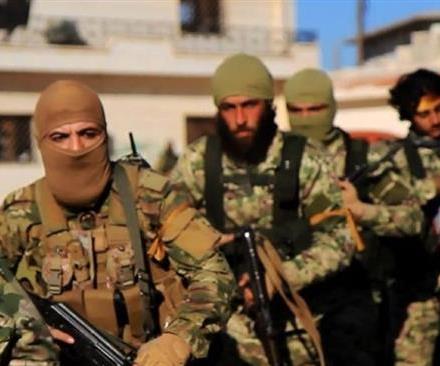 Fighting terrorism by the military means has always required a surgical precision and in-depth understanding of people and forces that take part in a local conflict. A well-known French expert on Islamic studies Gilles Kepel in 2000s explained a model of counter-terrorist activity that can still be applied for modern conflicts. According to this model if a responsive strike against Islamists is carried out without decent planning and leads to the casualties among the civil population, the civilians will start to sympathize terrorists, creating an impasse for conflict resolution.
Fighting terrorism by the military means has always required a surgical precision and in-depth understanding of people and forces that take part in a local conflict. A well-known French expert on Islamic studies Gilles Kepel in 2000s explained a model of counter-terrorist activity that can still be applied for modern conflicts. According to this model if a responsive strike against Islamists is carried out without decent planning and leads to the casualties among the civil population, the civilians will start to sympathize terrorists, creating an impasse for conflict resolution.
Let’s imagine that the provinces of Raqqa and Deir ez-Zor are freed from the Islamic State. It does not matter who will free them - Syrian Democratic Forces alliance with direct US military support or pro-government forces operating together with the SDF to claim some territories in these provinces. We may also omit the topics, which may fuel the conflict and contribute to ISIS revival: partition of the territories, ethnic and confessional misbalance and the timeframe for political settlement in Syria. It is just important that the East of the country is free from ISIS thanks to the joint effort that somehow resembles a broad international coalition, which Kremlin has long been pleading to create.
So, it may seem that the mission is accomplished – Russia and US have achieved their goals and can go on arguing which one of them has defeated ISIS. But will it mean that the terrorism has been obliterated? In order to answer this question some other issues should be cleared out…
Inconvenient questions
The military intervention in Syria has predictably divided Russian public into three main camps: those who are firmly in favor or against the participation of the country in the conflict and those who have a shifting position. The last group is mainly represented by the middle-class.
The partisans of the operation are sure that Russia has a long-term strategy in the Middle East, knows how to get out from the Syrian impasse and they approve of Kremlin’s decision to wage war against all the militants in Syria that is required “for us and for the whole world”. They discard any criticism towards Assad regime as “the Western conspiracy” and believe that Russia may risk being attacked on the rear by the remaining “other terrorists” if it engages ISIS in the East. They do not acknowledge that these “other terrorists” may be an opposition to the regime and consist of Syrians.
The opinions of the critics of the pro-government media are portrayed as cries of madmen, who are condemning unreasonably high military spending and losses, participation of Wagner Group, imperial ambitions and interests not only in Syria, but also in Egypt and Libya.
Ordinary Russian citizens who are fed by the media which blames everything on US and Gulf countries, speak about “fighting terrorism early on”, “ruining the plans of the damned West” and about the resolution to support the strategic allies – Damascus and Teheran. Although sometimes Afghanistan is recalled, Russians always comfort themselves by saying that it is a completely different case – the scale of involvement was different and the losses were significantly higher.
It is not worth an effort to participate in this argument. As always the truth is somewhere in between. But the qualified experts prefer not to risk their career and begin their publications or speeches on Syria by mentioning “the machinations of the West” and the terrorist nature of the entire Syrian opposition to please the ruling regime.
For instance, analysts in Russia should avoid the following topics:
- Why Russia launched its operation in the end of 2015 when the Syrian army was loosing and decided to side first with Shabiha and then with Iranian Shia International, letting them into the country?
- Whether the late intervention of Russia into the Syrian crisis is directly related to the Ukrainian crisis and to the willingness to impose a “dialogue on an equal footing” on the West?
- Whether Kremlin projects its perception of Russian opposition on the Syrian one and whether the list of the moderate groups is related to the forthcoming presidential elections in Russia?
- Why did Assad regime fuel Jihadi ideas among Sunnis during the Iraqi war and send “green buses” with militants from Aleppo and Damascus provinces to Iraq through border town of Al-Bukamal?
- Why did Assad regime free the most extremist imprisoned Islamists at the beginning of peaceful demonstrations?
If these issues are considered, Russia will have to admit that at first Damascus supported Islamists and suppressed healthy opposition, ignored Russia’s requests for extradition of extremists who fled to Syria after the war in the North Caucasus, and then took part in islamization of protest movements. For Russia it is better not to comment on the cooperation of Russia with Free Syrian Army in 2015 and on the bombardments of Liwa al-Haqq in Raqqa and Jabhat al-Nusra - in Deir ez-Zore, while these groups were not actually present in these cities.
So, it is very inconvenient to comment on these issues and it is in fact useless – any honest answers will be silenced by the wave of criticism. It is trendy to fight terrorism now. Thus, many Russian experts and media wrote about the “fall of ISIS in Aleppo” in the end of 2016 without even suspecting that the first ones to engage ISIS in Syria were the FSA units in Aleppo but not the Kurds in Kobani.
Syrian counter terrorism
From the very beginning of the military operation Moscow in fact refused to acknowledge the civil character of the war in Syria, depicting the conflict only as a struggle of Damascus against terrorists. Unfortunately, this idea became hardwired in Russian expert community and represents one of the gravest mistakes in the fight against terrorism made by Russia. The truce achieved in December despite the regime’s attempts to suppress the enclaves of opposition is surely the correct way to counter terrorism. However, even in the event of successful negotiations in Astana and the armistice preservation, there is still a risk that these measures will not be sufficient to resolve the real causes of the conflict.
The situation is aggravated by the fact that Syria and Iraq resemble communicating vessels (the so-called Wilayat al-Furat). And not only on the ground, but also underground: the Syrian-Iraqi border is crossed by the system of tunnels that was upgraded during Saddam Hussein rule. It is a perfect hiding place and R&R base for ISIS militants in case they lose Mosul and Raqqa.
Causes of “disease”
Despite the accusations of the US for ruining the balance in the region by launching the invasion in Iraq in 2003 that eventually led to the creation of ISIS and Sunni resistance, Syria is also partially responsible as it was a hiding place for many leaders of the would-be monster. Syria was a favorable country for the growth of then “Islamic State of Iraq” not only because of its refugee camps for the Iraqis but for the following reasons:
- Extremely violent means of protest repressions during the first eight months of the Syrian uprising;
- Ideological vacuum: a large share of Syrian Sunni were politically passive and lacked religious education;
- Confessional nature of the war waged by the Alawite Assad’s regime and his elites against the Sunni population, which became a gift for Al-Qaeda and later for al-Nusra, ISIS and other groups.
Instead of concentrating its efforts against Al-Qaeda and ISIS from the very beginning, Damascus focused on eliminating ideologically moderate armed groups thus augmenting the opportunities for extremist organizations. The strengthening of Shia groups just upgraded the scale of war.
The fight against Al-Qaeda and ISIS
The leadership of Al-Qaeda set a course to infiltrate Syrian revolutionary movement back in 2012 and used ideological pressure on poor Sunni population to achieve this goal. Generally speaking, Al-Qaeda’s involvement in Syria was not limited to Jabhat Fatah al-Sham. For instance, the exit of Jund al-Aqsa (then Sarayat al-Quds) in 2013 from al-Nusra when the latter confronted ISIS on the North of Syria, was conceived to assure the influx of foreign Mujahedeen to Idlib and Hama. In this sense, the religious rhetoric of Ahram al-Sham and Jaysh al-Islam largely prevented Syrians from joining international al-Nusra and Islamic state. Nevertheless, in the context of struggle with the regime in the West al-Nusra gained a reputation of the main military movement participating in the large-scale opposition operations. The rebranding of al-Nusra into Jabhat Fatah al-Sham and its divorce with Al-Qaeda was supposed to dissolve it among other fractions and make it an exclusively local movement. This new image was presented mainly for the Syrians themselves.
Unfortunately, Russian airstrikes, which continued the strategy of Damascus and Teheran, led not to the dispersion of the opposition but to consolidation of radical and moderate movements and to enforcement of al-Nusra by more than 3-4 thousands new Syrian recruits. So, the situation is aggravated by the fact that al-Nusra became a movement with a Syrian majority.
It seems that the IS will retain its capacity of the international terrorist organization, even in the event of the defeat in Syria and Iraq. Firstly, due to the spread in more than 20 countries they will still be able to maintain the brand of a “state”. And the independence of the branches of the parent company makes the situation more difficult. Secondly, the experience of the survival of Al-Qaeda after the defeat in Afghanistan tells that a relatively small area is needed to lead terrorist operations form "safe haven".
But the experience of Iraq shows that even a few dozen experienced jihadists are able to revive an old structure. In these conditions, reactionary methods should be replaced by a long-term counter-terrorism strategy.












